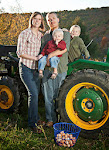So Carla and I went to Southern SAWG (Sustainable Agricultural Working Group). SSAWG is pretty much a gathering of farmers from across the Southern US. It attracts a lot of different farmers - Cajuns, young hippies, Appalachian folks, African-American ranchers, the diversity of folks is pretty amazing, as well as the types of farmers, governmental agencies, and non-profits that are there.

The last time Carla and I took a vacation was in 2006. No kids, no farm, just us getting started building a life and me trying to find my bearings after serving in Iraq. Carla was long overdue for some time out away from the youngins, work, and the farm. The picture above is us on top of Lookout Mtn in Chatanooga, TN. You can tell Carla's quite happy and I'm actually getting over a cold...

It was a work trip for me. I had the privilege of leading quite an eclectic group of pastured poultrymen/women, poultry processors, and potential farmers in a discussion session over challenges in poultry processing and marketing. Some really neat/successful farmers were there, and the discussion was fantastic. The first couple of days are workshops and field trips. Carla went to a local farm that raises pastured/forested pork (note the red wattle hogs below), grass-fed beef, pastured poultry, and has a dairy where they create superb cheese. Then there's two days of 1.5 hour topical sessions, six at a time (choose your favorite/most applicable one) on topics specific to the South.

The most interesting to me were ones given by Ann Wells and Greg Brann, on Management Intensive Grazing with small ruminants and cattle, and several on pastured poultry. There was also a neat course over rabbit production from a rabbit farmer who was so Tennessee in his bearing, that he was almost an Appalachian caricature. Carla went to sessions over record-keeping and planning for retirement on the farm. There was a lot to choose from:livestock, fruit, veggies, mushrooms, policy...it was all covered.
SSAWG will be in our neck of the woods next year - down in Little Rock, AR. Hopefully, we'll see you there!























